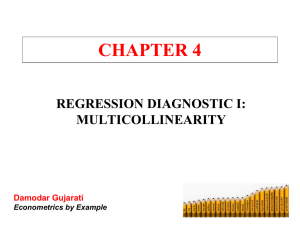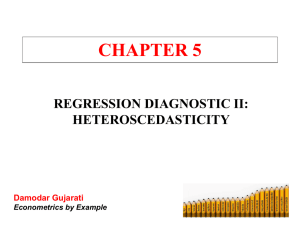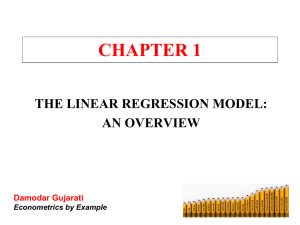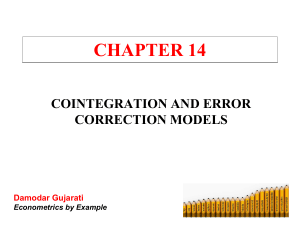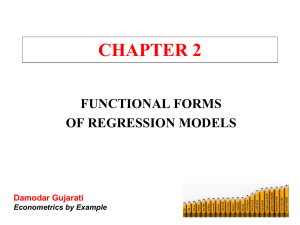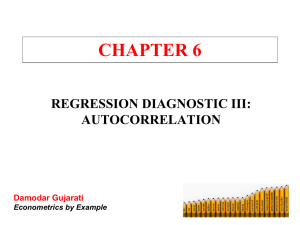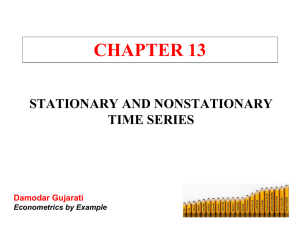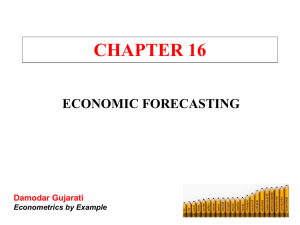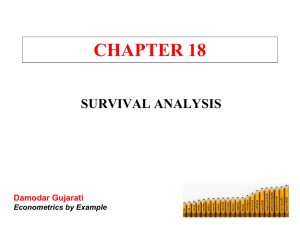Chapter 19
advertisement
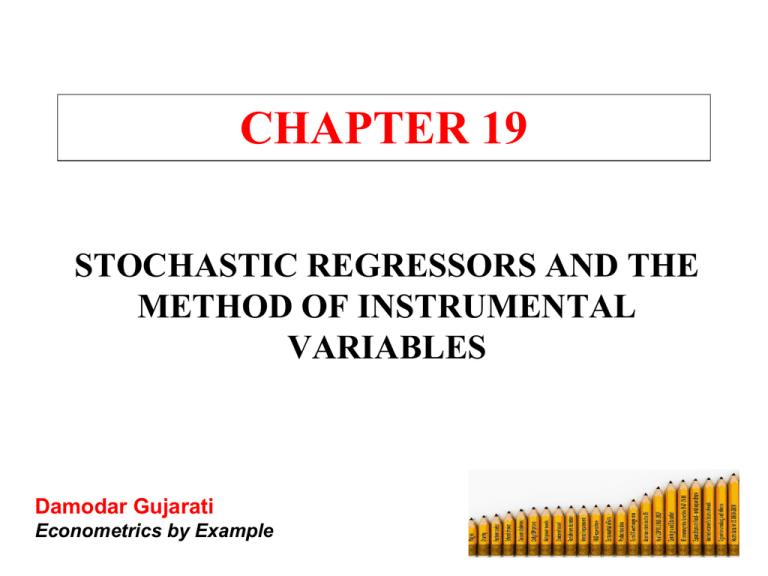
CHAPTER 19 STOCHASTIC REGRESSORS AND THE METHOD OF INSTRUMENTAL VARIABLES Damodar Gujarati Econometrics by Example STOCHASTIC REGRESSORS One of the critical assumptions of the classical linear regression model is that the error term and regressor(s) are uncorrelated. If they are correlated, we call such regressor(s) stochastic or endogenous regressors. In this situation the OLS estimators are biased and the bias does not disappear even if the sample size increases indefinitely. Therefore, the OLS estimators are not even consistent. As a result, tests of significance and hypothesis testing becomes suspect. Damodar Gujarati Econometrics by Example ASYMPTOTIC BIAS It can be shown that the difference between b2, the estimate of B2 (the true value of the coefficient on the stochastic variable) is equal to: cov( X i , ui ) var( X i ) If the covariance between the regressor and the error term is positive, b2 will overestimate the true B2, a positive bias. If the covariance term is negative, b2 will underestimate B2, a negative bias. Damodar Gujarati Econometrics by Example REASONS FOR CORRELATION BETWEEN REGRESSORS AND THE ERROR TERM 1. Measurement errors in the regressor(s) 2. Omitted Variable Bias 3. Simultaneous Equation Bias 4. Dynamic regression model with serial correlation in the error term Damodar Gujarati Econometrics by Example INSTRUMENTAL VARIABLES (IV) Proxy variables can give us consistent estimates of the coefficients of the suspected stochastic regressors They must be: (1) Uncorrelated with the error term (2) Correlated with the stochastic regressors (3) Not regressors in their own right Such variables are called instrumental variables or instruments. Damodar Gujarati Econometrics by Example IV ESTIMATORS In large samples IV estimators are normally distributed with mean equal to the true population value of the regressor under stress and the variance that involves the population correlation coefficient of the instrument with the suspect stochastic regressor. But in small, or finite, samples, IV estimators are biased and their variances are less efficient than the OLS estimators. Damodar Gujarati Econometrics by Example SUCCESS OF IV The success of IV depends on how strong they are. Instrumental variables must be strongly correlated with the stochastic regressor. If this correlation is high, we say such IVs are strong, but if it is low, we call them weak instruments. If the instruments are weak, IV estimators may not be normally distributed even in large samples. A rule of thumb says that an F- statistic in the first step of the Hausman test less than 10 suggests that the chosen instrument is weak. Damodar Gujarati Econometrics by Example IV ESTIMATION Stage 1: Regress the suspected endogenous variable (S) on the chosen instrument (Z) and the other regressors in the original model and obtain the estimated value of S from this regression, S-hat. Step 2: Run the main regression on the regressors included in the original model but replace the potentially endogenous variable by its value estimated from the Step 1 regression. Note that the standard errors will need to be altered. This method of estimating the parameters of the model of interest is appropriately called the method of two-stage least squares (2SLS), for we apply OLS twice. The value of the coefficient on S-hat will be equal to: IV 2 b zi yi zi xi where z, y, and x represent deviations from the mean values of Z, Y, and X, respectively. Damodar Gujarati Econometrics by Example TEST OF ENDOGENEITY OF A REGRESSOR Hausman Test Step 1: Regress the endogenous S on all the (non-stochastic) regressors in the original equation plus the instrumental variable(s) and obtain residuals from this regression. Step 2: Regress the dependent variable (Y) on all the regressors, including the (stochastic) S and the residuals from Step 1. If in this regression the t value of the residuals variable is statistically significant, we conclude that S is endogenous or stochastic. If it is not, then there is no need for IV estimation. Damodar Gujarati Econometrics by Example IDENTIFICATION 1. If the number of instruments equals the number of endogenous regressors, the regression coefficients are exactly identified, and we can obtain unique estimates of them. 2. If the number of instruments exceeds the number of regressors, the regression coefficients are overidentified, in which case we may obtain more than one estimate of one or more of the regressors. 3. If the number of instruments is less than the number of endogenous regressors, the regression coefficients are underidentified, and we cannot obtain unique values of the regression coefficients. Damodar Gujarati Econometrics by Example TESTING THE VALIDITY OF SURPLUS INSTRUMENT TEST OF OVERIDENTIFYING RESTRICTIONS 1. Obtain the IV estimates of the regression coefficients for the main regression. 2. Obtain residuals from this regression, e. 3. Regress e on all the original regressors, including the instruments, and obtain the R2 value from this regression. 4. Multiply R2 value obtained in (3) by the sample size n. It can be shown that nR2 follows the chi-square distribution with m df, where m is the number of surplus instruments. 5. If the estimated chi-square value exceeds the critical chi-square value, we conclude that at one surplus instrument is not valid. Damodar Gujarati Econometrics by Example
